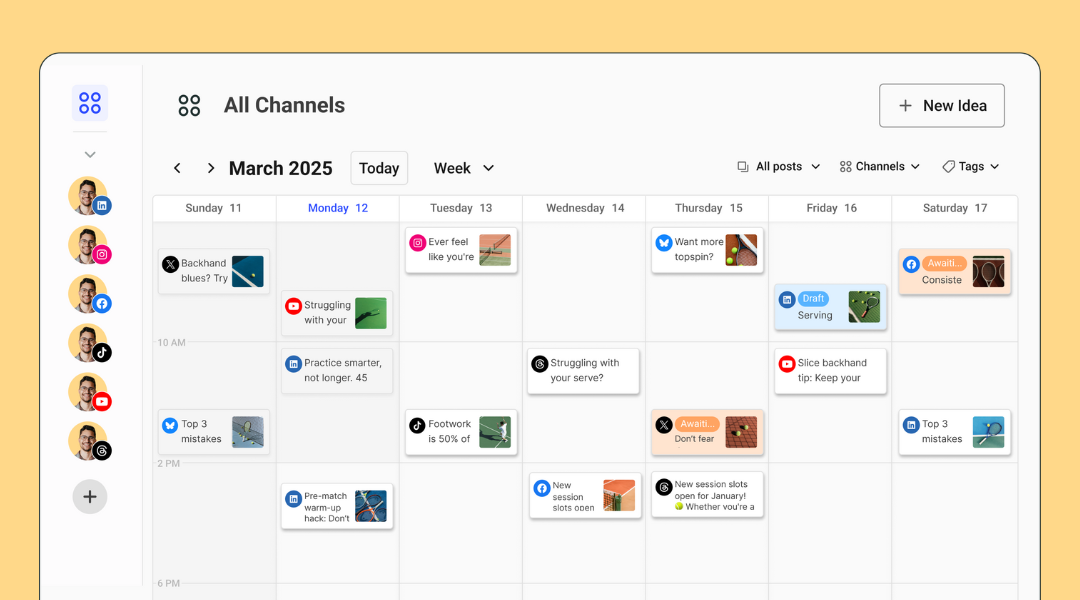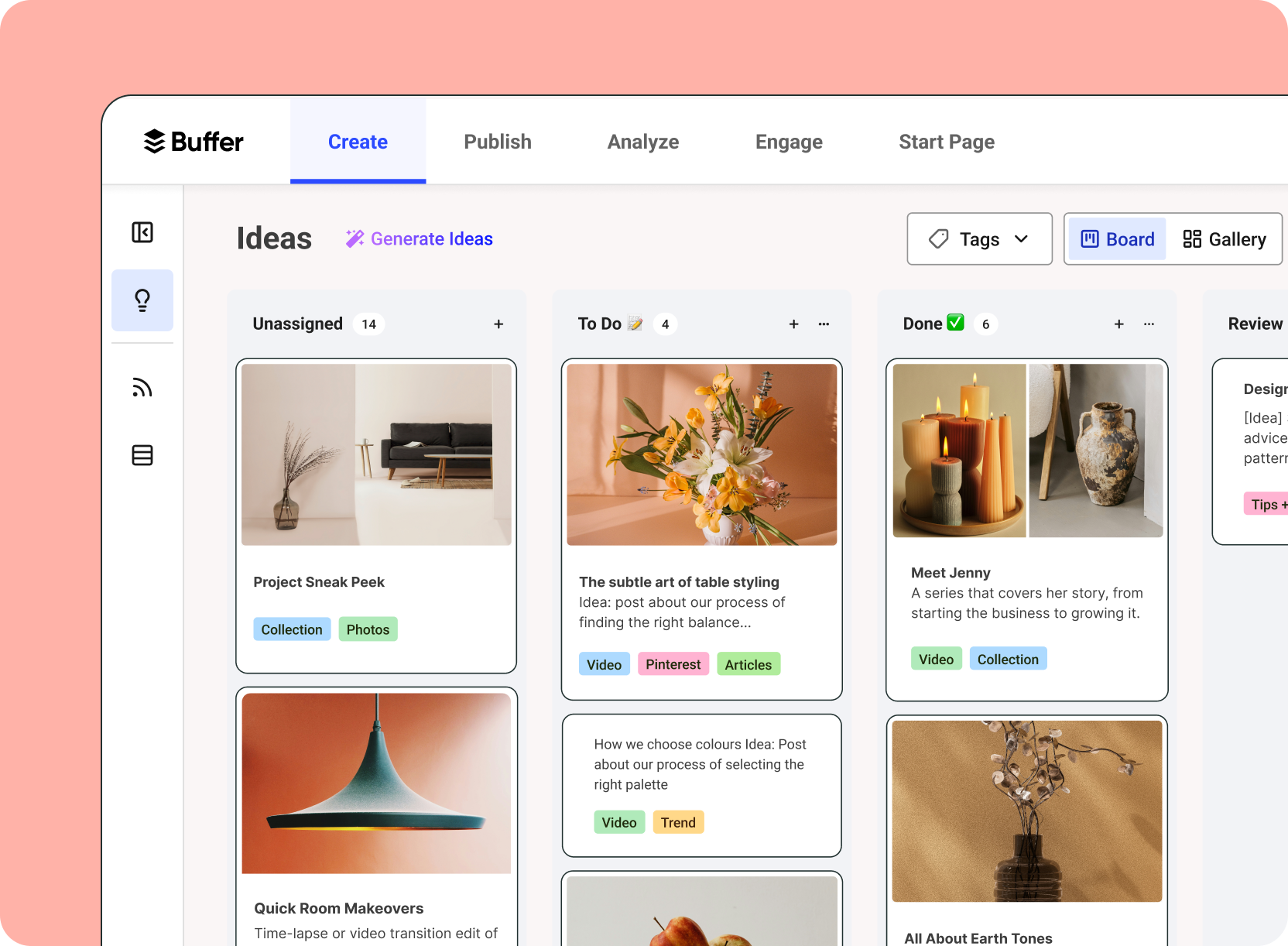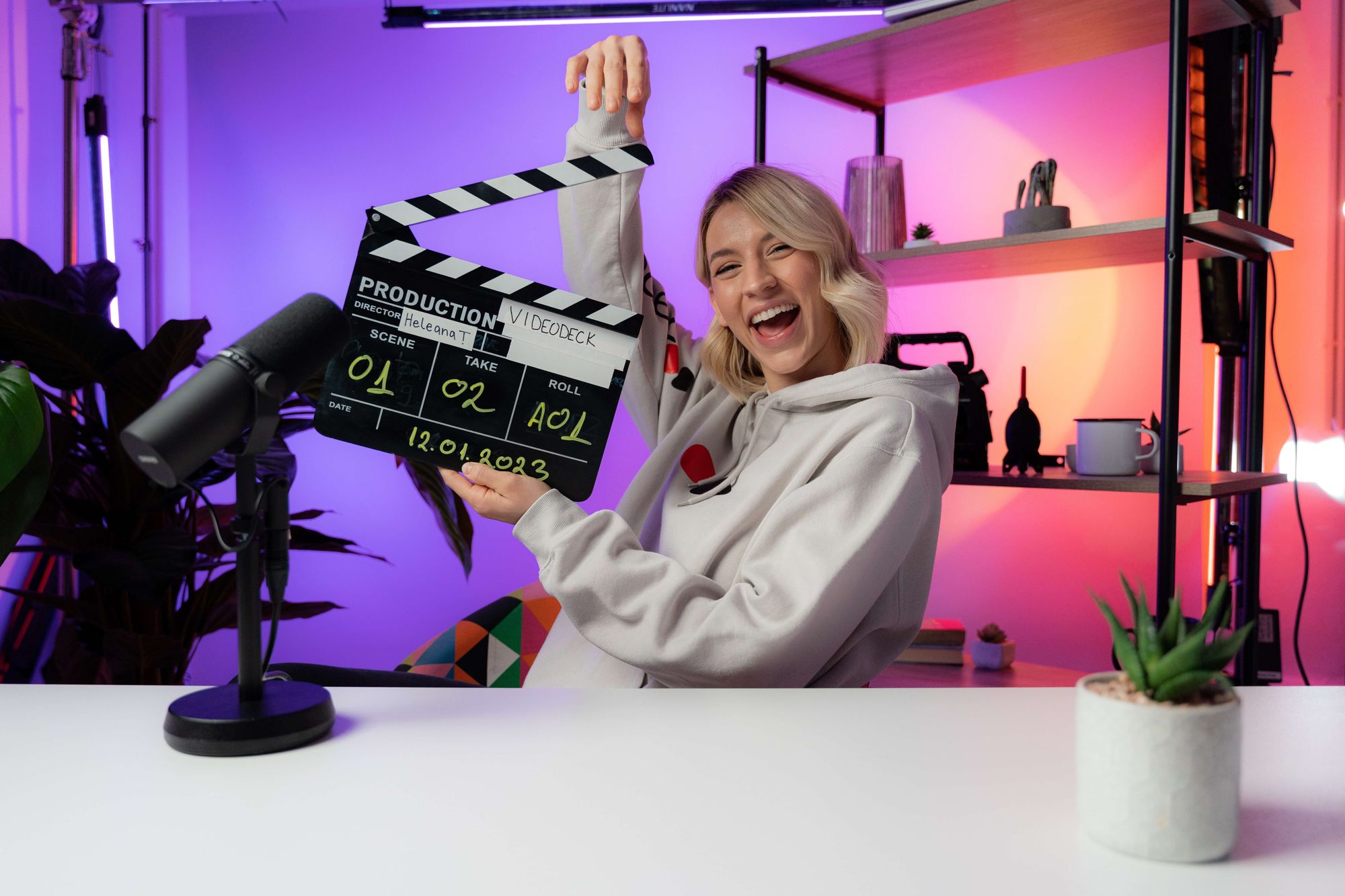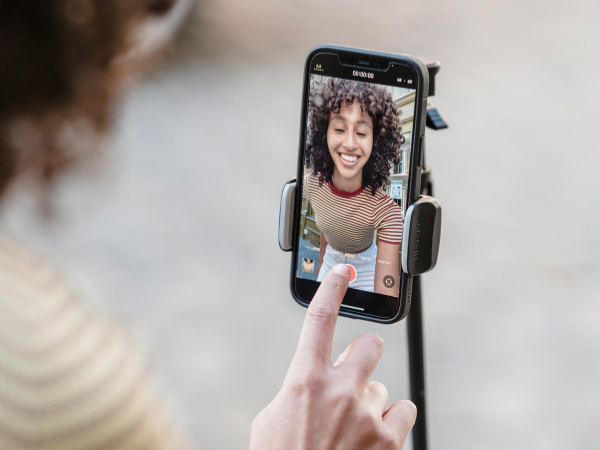
Video Marketing 101: How to Build a Successful Strategy in 2025 (+ Examples & Pro Tips)
An everything guide to getting started with video marketing — from content to equipment to editing, and more. Plus, real-life examples from creators and brands to inspire you.
As a creator or brand trying to get going with video marketing it can feel like everyone else has a ring light, a script, and a multi-camera setup — and you’re still figuring out where to start.
You know what helps to remember, though? All of those folks started out exactly where you are now.
Video is a great format to explore: it helps your audience connect with you more deeply and puts a face to the (brand) name. It’s not a trend; video marketing is here to stay.
Can you succeed in your social media marketing strategy with a text-first approach? Of course. We’ve got tons of data to prove it. You don’t need to hop on the video marketing bandwagon just because everyone says so.
However, if you’re shying away from video marketing only because speaking to the camera gives you fear tingles, I have a bumper guide here to make it less intimidating. We’ll unpack questions like:
- How do you get started with video marketing?
- How to create high-quality videos that perform well?
- How do you publish video content consistently without burning out?
I also share examples of my favorite creators and brands who are acing video marketing, so you have creators to look to for inspiration!
How to build a video marketing strategy in 7 steps
Video marketing can be overwhelming. But it becomes easier when you take one step at a time. You don’t have to learn and do it all in one day. Here’s a step-by-step process to follow for creating a successful video marketing strategy:
1. Determine how video fits into your overall social media marketing strategy
Video marketing has plenty of benefits: It helps you share authentic stories, foster a stronger connection with your audience, and become more memorable.
But don’t hop on video marketing just because everyone else is. You need to figure out how video marketing fits into your larger social media marketing strategy.
- Does it build trust with your social media community?
- Does it help build awareness by showing your products in action?
- Does it add a touch of human connection to your social profile?
- Does it help you repurpose content at scale and stay consistent with your social efforts?
Your video marketing strategy doesn’t work in a silo. Think of video marketing as a conduit to push your overall marketing strategies.
Once you determine where video marketing fits in your funnel, it also becomes easier to develop video content ideas.
For example, if you’re creating video content to build awareness about your product or service, you’ll focus on how-to videos and explainer videos. If you’re hoping to convert potential customers who are already product-aware, you might want to show off specific features and how they help solve common problems.
2. Decide which social platforms you will use for video marketing
Video content is present on almost all popular social media platforms. But that doesn’t mean you should have a video strategy for every social channel that supports it. That’s a quick road to creator burnout.
Start by focusing on social media channels where you’re already present. Would you benefit from adding video marketing to them? Beginning from a platform where you’ve already built a foothold also allows for more experimentation and quicker feedback from your audience.
Next, look at where your target audience spends most of their time. For example:
- More than half of Instagram’s users are 34 or younger.
- X (formerly Twitter) is most popular amongst the 25-34 age group.
- Facebook’s largest audience is men between the ages of 25 and 34.
- YouTube is the most popular social media channel of choice for Gen Alpha.
You want to create video content where your target audience is present and watching. If a majority of your target audience uses a social platform, it’s a good choice for your video marketing strategy.
Lastly, you want to examine which social platforms are suitable for the kind of videos you want to create.
- Instagram Reels are suitable for polished short-form videos.
- Facebook is good for long-form video content that uses storytelling.
- LinkedIn is best for thought leadership or behind-the-scenes video content.
- YouTube is best for long-form videos that require an in-depth exploration of a topic.
- TikTok videos are best for casual, off-the-cuff, and relatable short-form video content.
Learn more about which social platforms are right for you in our chat with Lindsay Gamble:
But remember that the above are general cultural preferences of the platform and aren’t set in stone. You can easily repurpose your TikTok videos for Instagram Reels, YouTube Shorts, and even Facebook Reels.
The difference in each social network isn’t so huge that you have to start from scratch for every platform. Create videos for one platform and adapt them for other networks as much as possible.
The ideal social platforms for video marketing will be a combination of the above three:
- Channels where you already have a social presence
- Channels where your target audience is present
- Channels that are suitable for your goals
For example, let’s say you’re growing your Instagram following and have an audience there. Your followers also watch Instagram Reels and TikTok videos, and your goal is to build deeper brand awareness. Then, Instagram Reels is the best choice for you to begin with.
To take it even further, choose adjacent networks like TikTok and Instagram because you can easily repackage video content made for one network for the other.
Creator, consultant, and speaker Jade Beason also recommends following your genuine interest.
“I started on YouTube because I naturally gravitate toward long-form, landscape video content. This made it easier for me to stick with it through all of the hard times, the flop errors, etc.,” she says.
“Go with the type of format you prefer, and that will tell you which platform to start with,” she adds. “TikTok is for you if you only like sharing short-form video content. If you like to have multiple formats, then maybe it’s Instagram. If it’s long-form, then it’s YouTube.”
3. Plan your content topics, video script, and content production in advance
Video campaigns require preparation before you can sit down and create the actual video. You need to figure out:
- Video production logistics (equipment, setting up your camera, etc.)
- Your content topics (for the whole video marketing campaign or just one video)
- A rough video script
Let’s break these down one by one.
🎥 Video production logistics
Understanding aperture, focus, and other complicated camera terms can be intimidating. But you don’t need fancy equipment to create high-quality videos. All you need is:
- A camera: A relatively new phone that can shoot high-quality videos is more than enough — you might also be able to boost your camera's video quality in your mobile settings. You don’t need a high-end camera to begin your video marketing efforts.
- A backdrop: You can use a simple wall background or a cute corner of your home. A green screen is also a good option if you need it.
- A microphone: While you can do without a fancy camera, I’d argue that a mic is a must. When your audio is crisp, your content feels more polished and professional — even if you filmed it on your phone. If you can, invest in microphones like Shure MV7 or a Rode Wireless ME. But even a relatively inexpensive plug-in lapel mic is more than enough. Something is better than nothing.
- Natural light: You don’t need a ring light right away. Try to shoot in places that get good sunlight, like directly in front of a window. And while you can just place your camera on a stack of books, a tripod can be handy to get the right angle.
In the beginning, try to ace just these three aspects of video production — it’ll ensure you have high-quality visuals and audio. As you get used to creating videos, you can layer more artificial lights, a better backdrop, etc.
Jade also advises choosing a comfortable location. “Film somewhere where you’re comfortable, especially in the beginning. The more comfortable you are, the easier it will be to come off as yourself on camera,” she says.
Remember — you don’t have to figure all of this out right away. You’ll learn as you go.
📚 Content topics
You might already have some ideas flowing after figuring out your goals, but also try to seek inspiration from:
- Other brands and creators: What video content are your competitors creating? How is it performing for them? Can you create videos on the same subject with your unique take? For example, creator Aakanksha Monga provided practical tips to make traveling more affordable (a common topic in her niche):
- Your audience’s comments, questions, and messages: The best source of content ideas is your audience. Are they asking a question or leaving feedback you could create video content about? Like any other content type, an effective video marketing strategy rests on the foundation of your audience’s needs. For example, business owner Anshita Mehrotra answered a question she received in her Instagram Stories in one of her reels.
- Trends: Is there any trend going on in your industry or in the social network as a whole that you could participate in? Tweak it to fit your niche so it doesn’t feel out of place. For example, creator Vibha Sree tried a viral Korean skincare product on Indian skin (since most of her audience is Indian).
🗒️ Video script
Jotting down some rough pointers on your opening sentence and the subtopics you want to cover is a good idea. But don’t just read your script for the camera. Instead, speak to the camera like you’re talking to a friend. Keep the script just to ensure you cover everything necessary in your video.
Setting up a teleprompter app (on your phone, iPad, or laptop) right at eye level behind your camera is also helpful. This can help jog your memory and reduce the number of takes you need for each video.
4. Batch create video content for all your social media platforms
One of the easiest things you can do to make video content creation less overwhelming is to batch-create video content. That means you’ll combine all similar tasks — like filming all your footage in one or two days. This way, you create multiple videos together in a short span. You can assign another day to edit the footage.
Freelance writer and creator Lizzie Davey uses this tactic. “I film a load of B-roll in one go that I can use for weeks/months afterward and upload all that footage into Canva so it's ready to use,” she says.
“Then, I have templates for the different types of videos I create, so I duplicate whichever type I plan to use and work from that instead of starting from scratch. I can then pull in the B-roll footage quickly and easily.”
Batch creation makes things easier because you don’t have to dress up and set up your camera, mic, and lighting daily. Instead, you do it just once or twice per week.
Once you’ve filmed a couple of videos, you’ll slot another day or two for batch editing. Here’s how that might look in a weekly schedule:
It’s also beneficial because you can capitalize on your flow state: You get in the zone of shooting and speaking to the camera or editing, and continue doing it instead of breaking out of that focused zone.
How far out can you batch create content? It depends on your schedule, marketing strategies, and industry.
For example, if you want to post two short-form videos a day on TikTok, you can perhaps create a week’s worth of content (14 videos) in two or three days. But if you can take it a little slower, you can create content even further in advance. If you work in a time-sensitive industry (like the news niche), you can only create content maybe a few days in advance.
Either way, we wouldn’t recommend creating videos too far ahead — a month at most. This is because your video content creation capabilities refine with time and practice. You want to make the most out of your skills without rushing the process. Plus, if you get any fresh content ideas in the middle, it’s not worth postponing them too much.
Jade agrees. “The biggest mistake people make is they try to do too much too soon,” she says. “Creating video content yourself is a huge task, especially when you don’t have any video production or editing background.”
“Start with a platform that feels comfortable for you, and keep making micro-improvements in your journey. That way, creating video content won’t feel like this huge mountain you have to climb.”
5. Edit your videos using video editing tools
Now your editing time is scheduled in your calendar — but how do you do that, exactly? Many social networks have in-built video editing capabilities, but you can also incorporate video editing tools to take it up a notch. Video editing tools can help you edit videos for multiple platforms in one go and also refine your overall editing skills.
Here are some video editing tools you can try:
- CapCut is one of the best free video editors, especially for editing TikTok videos. You can even add trending TikTok audios directly in CapCut to your videos (if you’ve saved them on TikTok). CapCut is also quite beginner-friendly! There are paid plans for advanced editing features.
- Canva has the best template library, but the video editor is a little basic. If you’re a beginner on a time and budget crunch, Canva’s templates will come in handy.
- Descript has transcript-based editing, so you can edit your videos using your script. If you erase something from the transcript, it gets cut from the video (like magic!). This tool is best for the kind of videos that can have a lot of filler, like podcasts. Some of its best features are limited to the paid plan, though.
How do you edit video content like a pro? Firstly, remember it takes time to learn advanced video editing skills. It’s not something you can gain overnight. The good news? The more you edit your videos, the finer your video editing chops will get.
That said, here are some video editing tips you can apply right away:
- Trim the fat: Cut any unnecessary clips from your videos and keep only the content that’s 100% necessary to deliver the message. This will make your videos sharper and engaging.
- Use transitions: Transitions can make a video snappier and more entertaining. They’re also an excellent tool for storytelling. Add transitions — especially in your short-form video content — to keep your video viewers hooked.
- Add captions and text overlays: Your video viewers are often watching video content on mute. Make it a best practice in your video marketing to always add text overlays and subtitles to your videos. Cherry on top: They also make your video more accessible.
6. Schedule your videos using social media management software
You’ve shot and edited your video footage for multiple videos. What next? Your video strategy is incomplete until you publish video content consistently. Our research found consistent posting gets you five times ( 🤯) more engagement than inconsistent posting.
Content batching and batch editing will help you stay consistent because you’ll shoot and edit videos in advance. The next step is using a social media management software so your video content goes out automatically instead of you publishing it manually.
A marketing tool like this is one step above a content calendar: It not only shows which content will go live on what date, but also automates the task of publishing.
There are plenty of such tools in the market, but my favorite is Buffer. Not only is it super easy and intuitive to use to connect your social channels and schedule video content, but it also has built-in social analytics, engagement features, AI capabilities, and a lot more. It’s the whole package.

My most used feature is the Create space. Whenever I get a content idea — which is often when I’m not at work — I can just open my Buffer mobile app and jot it down.
The organization nerd in me is ecstatic that I can even assign tags to it to make my content library even neater. Now, when I sit to create content, I already have a backlog of content ideas ready for me to work on. Sayonara, blank page syndrome.

You can do all of this under one tab and for free! Getting started with video marketing might be overwhelming, but getting started with Buffer is easy-peasy.
7. Analyze your performance metrics regularly to understand what’s working
A crucial component of any digital marketing strategy is analyzing your performance and understanding what’s working and what needs improvement. Video marketing is no different.
Which metrics should you monitor? If you’re just starting with video marketing, video views are the most important performance metric to understand whether or not you’re increasing your reach.
As you keep posting consistently, also analyze each individual video to understand which videos get the most engagement. Maybe they are all about a specific topic in your niche. Dice and slice the data to understand your audience’s preferences: Do instructional videos perform better than explainer videos? How do how-to videos fare compared to testimonial videos? The goal is to find patterns so you can replicate your success.
Each social network will have native analytics to help you understand how your video content has performed. But if you want to look at analytics from all your social profiles together, it’s best to use an analytics tool. I love Buffer’s analytics feature because it doesn’t just throw numbers at you; it does the work of finding your:
- Best type of post
- Best day to post
- Best type of content to post
Which metrics you care about will also depend on your video marketing goals. For example, video views are important if your goal is to increase brand awareness. However, click-through rates might be more vital if you aim to boost conversions.
Set aside a few minutes each week to analyze your video content performance. And let the insights you gain fuel your future video content creation.
7 of our favorite video marketing examples from creators and brands
What does effective video marketing look like in action? Here are seven examples to help inspire you:
1. Morning Brew
Morning Brew is a business media company that regularly publishes business-related news on all its social channels.
@morningbrew JP Morgan’s RTO plans #jpmorgan #banking #business #wallstreet
♬ original sound - Morning Brew
Their video content is often time-sensitive and has a touch of humor. They’re taking this up a notch by also releasing a show on YouTube.
What you can learn from Morning Brew’s video marketing: Morning Brew aces social listening with its video content. They’re always on top of the news and simplify its impact for their audience. Try to become the go-to reliable source of information about the latest news in your industry using video content.
2. Modash
Modash is an influencer marketing tool that has recently doubled down on its YouTube strategy.
What I love about their YouTube channel (beyond the engaging visuals) is that almost every video is repurposed from a guide already on their blog. For instance, the above video was adapted from an influencer gifting guide on the Modash blog.
What you can learn from Modash’s video marketing: If you already have marketing assets you can repurpose for video content, do it! It’ll make it easier to get started and provide additional ways for your audience to consume the same content.
3. Katie Gatti Tassin
Katie Gatti Tassin is the face behind The Money With Katie Show. She often shares stitches from other popular TikTok videos with her opinions.
@moneywithkatie thanks to @miss redacted✨🪩🩷🇵🇸 for inspiring this lol
♬ original sound - Money with Katie
Katie also crossposts this on her Instagram account, where she has more followers than TikTok. Stitching with another video is a low lift way to not only get more content ideas, but also appear in front of more people who’ve already seen the video.
What you can learn from Katie’s video marketing: When you come across popular videos in your niche and want to add to it, stitch (for TikTok) or remix (for Instagram) with those videos to improve your reach.
4. Deya Aliaga Kuhnle
Deya Aliaga Kuhnle is a business owner who shares her business journey and advice using her YouTube channel.
What stands out in Deya is her candidness in speaking openly about her struggles and transparently about her numbers. This builds trust and helps her audience connect with her better.
What you can learn from Deya’s video marketing: Let your personality shine in your video content. It’ll set you apart and make you more memorable. Try to be as transparent and authentic as you can — just like you are offline.
5. Heike Young
Heike Young is the Head of content, social, and integrated marketing at Microsoft. She has a strong personal brand on LinkedIn — and most of that has been built on video content.
The one word that comes to mind when you see Heike’s content is ‘relatable.’ Whether it’s her candid, straightforward advice or hilarious skits, Heike speaks to all marketers’ struggles.
What you can learn from Heike’s video marketing: Relatability is a massive component of making your video marketing campaigns successful. Show your audience you understand their problems and pair it with your product or service as the solution.
6. Superboba
Superboba is a small business selling vegan milk teas. The company’s Instagram goes beyond the traditional ‘buy from us!’ approach and shares a ton of behind-the-scenes video content.
Superboba’s videos often feature its co-founder, Vanessa Oi-Gwan Lau, making the audience feel more connected to the brand.
What you can learn from Superboba’s video marketing: Brand videos don’t always need to be just about the product. Incorporate authentic behind-the-scenes content into your strategy. This will make the audience feel more connected to your company and build more trust.
7. YNAB
You Need A Budget (YNAB) is a personal finance and budgeting app (that I’ve been personally using and loving for years!). The company’s YouTube game is super strong and worth taking a few lessons from.
YNAB’s YouTube strategy is a mix of product tutorials and educational content about personal finance. Like Morning Brew, YNAB aces social listening and answers their audience’s pesky questions — but they do so with evergreen content.
What you can learn from YNAB’s video marketing: If your product or service requires educational content, lean into it with an entertaining, story-driven approach. But don’t forget to mix it up by answering your audience’s evergreen questions in your niche — even if they aren’t directly related to your product or service.
How to create quality video content regularly without burning out? 7 pro tips
Video marketing is about working hard and working smart. Before I share some practical advice for creating quality video content sustainably, it’s worth noting that in the beginning, creating a single video will take hours, and editing, if you’re new to it, will come with a bit of a learning curve.
There’s no way to skip that phase — but I promise, it will get easier!.
If you keep at it, your patience will pay off, and each task will be completed faster. And you’ll even enjoy video content creation more.
1. Repurpose existing content
Repurposing content is the number one way to extract the most from your video content without creating new videos from scratch.
The best part? Repurposing allows for a ton of creativity. You can do a lot beyond converting one long-form video into various short-form videos (although that’s quite neat).
- Do you have a long-form blog post? Consider it your script and repurpose it into video content. Summarize the key points and add high-quality visuals.
- Do you have an audio-only podcast? Use a marketing tool like Audiogram to convert your transcript into shareable video content.
- Did you create various short-form videos on a topic? Combine those clips to make a long-form video.
Repurposing offers endless possibilities. Instead of constantly brainstorming new video content ideas, make room to think creatively about recycling existing videos into more video content.
2. Content batching
We’ve already discussed it, but batch creating your video content will reduce your mental load, eliminate context-switching, and allow you to get into deep work mode.
Schedule one day for filming each week or each month (depending on your posting frequency). Change your outfit and tweak your background slightly to have some variety in your videos. Always do a test run first to ensure the mic placement, lighting, and everything else is correct.
3. Use video templates
You can create a classic reusable video template so you don’t have to think about creative video content production every time.
For example, you can have a content format for customer testimonial videos where you ask them a set of similar questions. This doesn’t require a ton of creative energy and allows you to stay consistent with your video strategy.
Many video editing tools, like Canva, also have video templates built-in. Even Instagram has a ‘Use template’ option in some of its trending videos.
Templates make it easy to combine your clips and create a stunning video, without spending too much time editing. Have a handful of templates handy so you can rely on them — especially for busy weeks when you’re drained but need something to keep your publishing streak going.
4. Reuse your video clips
One video clip can have a long shelf life. Use high quality visuals multiple times in your videos — especially generic B-roll. I promise no one notices. Even if they do, they don’t care as long as it doesn’t impact the quality of your video content.
Organize your video clips into folders like customer testimonials, animations, behind the scenes footage, etc. This will make them handy to reuse whenever you need them.
5. Repost your video content
It might sound wrong, but there’s no shame in reposting your video content.
- Repost videos that didn’t perform as well as you hoped to check if it was just a timing issue.
- Repost videos that outperformed your expectations to check if they’ve stood the test of time.
Either way, not all of your followers have seen every single one of your videos. Reposting allows your video content to reach more people. And even if someone comes across a reposted video, 99% of the time, they’ll not mind watching it again.
6. Embrace low-lift content formats
Some video marketing is comparatively lower lift than others — like talking-head videos or behind-the-scenes content. Use them as much as you can to maintain a consistent posting schedule.
And even in other content formats like explainer videos or how-to videos, don’t strive for perfection as much as you strive for authenticity. You don’t need every tiny detail to be impeccable in your video frames. Authentic is always better than overproduced, and done is better than perfect. Don’t get in your own way.
7. Start a content series
A content series is when you create multiple videos around the same topic. It’s a great addition to your video marketing strategy because it allows you to go in-depth on one of your content pillars and also reduces decision fatigue.
For example, if you’re a food creator, you could start a ‘15-minute recipes’ video content series to show your audience meals you can make quickly after a tiring workday. You can imbibe several of these into your video marketing strategy and use them when you’re out of new content ideas.
7 pro tips to help you succeed at video marketing
It can be disheartening to pour your sweat and tears into creating video content, only for it to fall flat. While no one can guarantee the success of your video marketing strategy, it’s possible to take a few proactive steps to stack the odds in your favor.
1. Optimize your video for SEO
Almost all social platforms have search engine capabilities today. Google even shows YouTube videos at the top of search engine result pages (SERPs) for various keywords.
Social search engine optimization is using the right keywords in your video title, subtitle, and description/caption. Whenever you’re creating a video on any topic:
- Conduct a quick competitor analysis by searching for the term yourself to see what others have covered and missed.
- Use a search engine optimization tool like Semrush or Ahrefs (if you already have a content marketing strategy) to find related keywords and questions on your video topic. A free tool like Answer The Public can also suffice.
- Add relevant and popular hashtags to improve the visibility and discoverability of your video content.
Ensuring you add and speak relevant keywords can improve your video performance and also help you appear on search engine result pages.
2. Have hooks that stop the scroll (especially for short-form videos)
A hook is the beginning sentence or phrase of your video. It should be captivating enough to stop someone from scrolling (and then the video should be engaging enough to keep them hooked till the end).
How do you make your hooks more enticing?
- Notice what makes you stop the scroll and dissect why. Use the same principles in your own video content.
- Use copywriting formulas and power words to entice curiosity and perk up people’s ears.
- Iterate and refine your first hook multiple times before landing on the final one.
Lizzie suggests experimenting with various hooks. “I think the biggest thing that helped improve my video performance was keeping the videos simple and adding really engaging hooks,” she says. “Try experimenting with different types of hooks and video formats to see what works best for your audience, because it might be very different.”
3. Tell stories, not just facts
Humans are wired to love and remember stories. When creating video content, ask yourself: Am I sharing a story or just sharing information? If it’s the latter, try to connect a human story — either from your life, your brand, or even a fictional one (as long as you state that it’s fictional!) — to your info to make your videos more memorable and engaging.
A great example here would be using a customer case study along with a stat like, “Our tool saves you X hours per week.”
Storytelling is also a skill that will develop over time. But if you view your video marketing from the story-driven lens from the beginning, it’ll ensure you build a foundation for success from day one.
4. Show your personality
Video marketing is about building a deeper connection with your audience and showing them who you are in real life as closely as possible. So don’t create a ‘professional video’ just because you think you’re supposed to. Are you funny and goofy in real life? Let that shine through in your video content.
Jade says an easy way to show your personality on video is to ditch the video script and just use a few prompts instead. “
What’s helped me the most is not scripting my videos,” she says “I write prompts for my videos to get a rough idea of what I’m trying to get across. I don’t read these prompts out; I simply refer to my notes and then I let myself speak freely.”
“Doing this gives me the ability to share my thoughts in a way that feels personal to me, to go on tangents should I feel the need to do so, and even make mistakes.”
Showing your personality online can be scary (what if they don’t like me?) because it requires vulnerability. But it’ll foster a stronger relationship with your followers and make you much more memorable.
5. Capitalize on trends and trending sounds
Trending content can help you improve your chances of success and even go viral. Especially with short-form video content, there are always tons of trending sounds or trends floating on social networks.
Leave some room in your content calendar to create trending content. Remember, these trends are time-sensitive, so you must hop on the bandwagon quickly — before the trend becomes irrelevant.
6. Have a niche
We’re all for experimentation here at Buffer. But there’s no denying that having a niche — even a broad one — is a solid strategy for success.
When you have a niche, you have some focus on your content topics. This allows the algorithms to understand what your account is about and put it in front of the right people. Your audience also starts knowing you for one thing when you solidify a niche.
In a TikTok experiment that increased her following by over 1,000% in 30 days, senior content writer Kirsti Lang, found that having a niche (or connected niches) was a core contributor to her success.
“When viewers enjoy a video in your feed, they’ll tap over to your profile to see if there are more. And if what you find there is a hot mess of all sorts of unrelated things, you’re going to bounce back to their home without tapping ‘follow,” she says.
“A random assortment of videos might help you go viral every now and then (if you’re lucky), but they’re not the smoothest path to audience growth.”
Want to learn more about how you can find your niche as a creator? Learn from Gigi Robinson:
7. Create a video distribution plan
Video marketing doesn’t have to stay limited to your social strategy. Video content has lots of use cases beyond that
- Created explainer videos about how your product works? Use them as demo videos on your website.
- Created video content to promote your brand story? Embed it in the ‘About’ page of your own website.
- Created customer testimonial videos? Add it to your case studies and sales deck to pitch to future customers.
Measuring video marketing success will also change as you evolve your distribution plan. Instead of just measuring the social impact, look at the bigger picture of how video content has improved your overall business.
Lights, camera, practice!
If you’re just getting started with video content, give yourself some time and grace. Your first video won’t be perfect (and likely not your second, either). Creating videos involves many tasks at once, and it takes time and practice for everything to click.
Want to make it a little smoother? Use a tool like Buffer to ideate, schedule, and analyze your video content across all social platforms. You focus on improving your video ideas, filming, and editing — leave the rest (read: tedious) tasks of scheduling posts, analyzing content, and planning a content calendar to us. Here's how to get started.
Try Buffer for free
180,000+ creators, small businesses, and marketers use Buffer to grow their audiences every month.
Related Articles

In this article, we break down the YouTube algorithm according to YouTube insiders and share tips for applying this knowledge to your videos.

Unlockable reels are designed to encourage “a new, IYKYK way” of engaging with your community on Instagram. Here's how they work.

After some serious hands-on time with Edits by Instagram, here’s my everything guide, from getting started to tips and tricks to take you to the next level.
